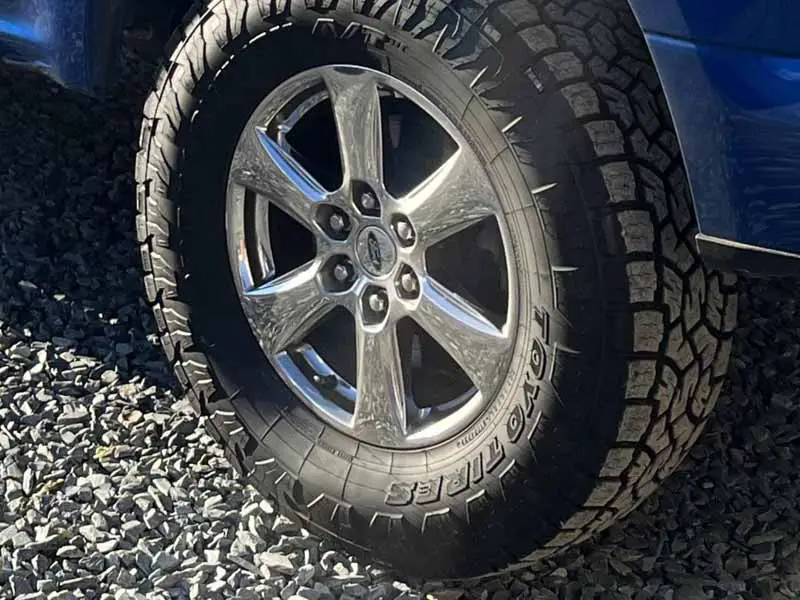Choosing between Light Truck (LT) and Passenger (P) tires can be a puzzling decision, especially when you consider the impact on your vehicle’s performance, safety, and comfort. If you’re looking for a straightforward guide to making the right choice without getting lost in technical jargon, you’ve come to the right place.
LT Vs P Tires
Light Truck (LT) tires are designed for vehicles that carry heavier loads and encounter rough driving conditions, while Passenger (P) tires are made for everyday vehicles with lighter loads and a focus on a smooth ride.
In this article, we will explore the differences between LT and P tires, helping you understand which is suitable for your vehicle based on its usage, load requirements, and the driving conditions you typically face.

Understanding Tire Designations
When you look at tires, you might notice they have letters like ‘LT’ or ‘P’ before the numbers on the sidewall. These letters are very important because they tell you what the tire is made for.
What Does ‘LT’ Mean?
‘LT’ stands for Light Truck. Tires with an ‘LT’ designation are built for vehicles that need to do tough jobs like carrying heavy things or towing trailers. Here’s what you should know about LT tires:
- They are stronger: LT tires are made to handle more weight and tougher driving conditions.
- They have a different build: Inside the tire, there are more materials that make the tire stronger for carrying heavy loads.
- They can handle rough roads: If you drive on rough or unpaved roads, LT tires are designed to cope better with these conditions.
What Does ‘P’ Mean?
On the other hand, ‘P’ stands for Passenger. This means the tire is made for passenger vehicles like cars, minivans, and some light-duty pickup trucks and SUVs. P tires are made for everyday driving – going to work, taking kids to school, or trips around town. Here’s what P tires are like:
- They are for lighter loads: P tires are not meant for heavy loads but for comfort and fuel efficiency.
- They provide a smoother ride: Because they’re made for lighter vehicles, they can make the ride feel smoother.

The Significance of Load Range and Tire Durability
When selecting tires for your vehicle, understanding the concept of load range and the expected durability of the tires is crucial. These factors directly impact the safety and efficiency of your driving experience.
What is Load Range?
Load range indicates how much weight a tire can safely carry. It’s a critical factor for those who frequently carry heavy loads or tow. Here’s what you need to know:
- Higher load range means more weight: Tires with a higher load range can carry more weight, which is essential for vehicles that are used for more than just driving around town.
- Marked by letters: The load range is usually marked by letters like B, C, D, E, etc., with each letter indicating a higher capacity to carry weight.
Tire Durability: LT vs. P Tires
Tire durability refers to how long a tire can last before it needs to be replaced. Here’s how LT and P tires differ in durability:
- LT tires are often more durable: Because they’re built to handle tougher conditions, LT tires can often last longer, especially under heavy use.
- P tires may wear faster under heavy use: If you put P tires on a vehicle that carries heavy loads, they may wear out faster than LT tires would.

Ride Quality: LT Tires vs P Tires
The type of tire you choose for your vehicle has a significant impact on the comfort of your ride. LT and P tires are designed for different purposes, and this affects how they feel when you’re driving.
How LT Tires Affect Ride Quality
LT tires are built for heavier loads and tougher conditions, which means they have certain features:
- Stiffer construction: LT tires have stiffer sidewalls to handle heavier weights, which can lead to a bouncier ride.
- More road feedback: You might feel more of the road’s bumps and dips with LT tires.
How P Tires Affect Ride Quality
P tires, on the other hand, are designed for a smoother ride in everyday driving conditions:
- Softer sidewalls: This allows for a more comfortable ride, absorbing the bumps and imperfections of the road.
- Quieter: P tires typically produce less noise on the road, which can make for a quieter cabin experience.

Vehicle Applications and Tire Selection
Choosing the right tire for your vehicle is not just about size and fit; it’s about matching the tire to what your vehicle does on a daily basis. Let’s break down which vehicles should typically use LT tires and which should use P tires, and why this matters.
When to Choose LT Tires
LT tires are designed for vehicles that work hard. Here’s when they make sense:
- Heavy-duty trucks: These are trucks designed for more than just driving; they’re for hauling and towing significant weight.
- Commercial vehicles: Vans, trucks, and SUVs used for business purposes, carrying equipment, goods, or passengers, often require the extra strength of LT tires.
- Off-road vehicles: If you frequently take your vehicle on unpaved roads or rough terrain, LT tires provide the durability needed.
When to Choose P Tires
P tires are suitable for vehicles that are used in a more conventional manner:
- Everyday passenger cars: Sedans, hatchbacks, and coupes used for commuting and city driving are well-suited to P tires.
- Light-duty SUVs and trucks: If you’re driving a truck or SUV that doesn’t carry heavy loads or tow, P tires can offer a more comfortable ride.
The Risks of Choosing Wrong
Using the wrong type of tire for your vehicle can lead to problems:
- Reduced performance: A tire not suited for the weight and usage of the vehicle won’t perform as well, which can affect handling and safety.
- Increased wear: The wrong tire type can wear out faster. For example, P tires on a heavy-duty truck will deteriorate quicker due to the extra load.
How Long Do LT Tires Last Compared to P Tires?
The lifespan of a tire can vary based on several factors, including the type of tire, driving habits, and maintenance. Here’s what you should consider:
- LT tires: They are designed for heavier use and may have a longer lifespan when used under the conditions they were designed for, such as carrying heavy loads or frequent towing.
- P tires: While they may not last as long under heavy use, they are designed for everyday driving and can have a sufficient lifespan when used appropriately.
Factors Affecting Tire Longevity
Several factors can influence how long your tires last:
- Driving conditions: Rough roads can wear down tires faster.
- Tire maintenance: Regular rotation and proper inflation can extend the life of your tires.
- Driving style: Aggressive driving can lead to faster tire wear.
Knowing When to Replace Your Tires
It’s crucial to know when it’s time to replace your tires for the safety of your vehicle. Here are some signs:
- Tread depth: If the tread is worn down to 2/32 of an inch, it’s time to replace your tires.
- Visible damage: Look for cuts, cracks, or bulges in the sidewall.
- Age: Tires should be inspected regularly after five years and are recommended to be replaced after ten years, regardless of tread depth.

Special Considerations for Trucks and SUVs
Trucks and SUVs often come with a choice between LT and P tires, and the decision on which to use should be informed by the vehicle’s intended use and the driver’s priorities. Let’s delve into the considerations for these vehicle types.
When to Use Passenger Tires on Light Trucks
Passenger tires on light trucks are suitable under certain conditions:
- Lighter loads: If you’re not hauling or towing heavy loads, P tires can suffice.
- Mainly on-road driving: For regular commuting or road trips without the demand for heavy-duty tire performance, P tires offer a smoother ride.
- Fuel efficiency: P tires tend to offer better fuel economy due to their lighter construction and lower rolling resistance.
However, it’s crucial to ensure that the P tires can handle the maximum load of the truck when it’s fully loaded. Overloading P tires can lead to tire failure.
When LT Tires Are the Right Choice for Your SUV or Truck
LT tires might be necessary for your SUV or truck if:
- You carry or tow heavy loads: LT tires are designed to handle the extra weight and stress.
- You drive on rough terrain: If off-road driving is a regular activity, LT tires provide the durability needed.
- You require more tire robustness: For work-related driving where the vehicle undergoes more stress, LT tires are more appropriate.

Making the Right Choice for Your Vehicle
When it’s time to choose new tires for your vehicle, the decision between LT and P tires is significant. This choice should be based on your vehicle’s requirements, your driving habits, and the conditions you typically drive in. Here’s how to make the right choice for your vehicle.
Assessing Your Vehicle’s Needs
Start by considering the following:
- Vehicle type: Check your vehicle’s owner’s manual for the manufacturer’s recommendations on tire types.
- Weight capacity: Ensure the tires you choose can support the full weight of your vehicle, especially when loaded.
- Usage: Think about how you use your vehicle. If you frequently carry heavy loads or drive in challenging conditions, LT tires may be necessary.
Understanding Your Driving Habits
Your driving habits play a crucial role in selecting the right tire:
- Daily driving conditions: If you’re mostly on highways and city streets, P tires are designed for these conditions.
- Off-road or rough terrain: If your adventures take you off the beaten path, LT tires will be more durable and safer.
- Towing and hauling: Regular towing and hauling heavy loads require the additional strength of LT tires.
Considering Tire Features
When selecting tires, consider their features and how they align with your needs:
- Tread life: LT tires may offer a longer tread life under heavy-duty use, while P tires are sufficient for regular driving conditions.
- Ride comfort: P tires generally provide a smoother and quieter ride for everyday use.
- Fuel efficiency: P tires can help improve fuel efficiency due to their lighter construction.
Resources
Below are some links you may find helpful when learning about tires:
- Tire buying guide: What to know before you buy new tires – Consumer Reports
- How to choose tires – Car and Driver
Final Thoughts
LT tires are best for vehicles that frequently handle heavy-duty tasks, while P tires are suitable for everyday driving and lighter loads.
Consider your vehicle’s typical use, the conditions you drive in, and the load you carry to make the best choice. Don’t forget to consult your vehicle’s manual and consider seeking advice from a tire professional if you’re uncertain.
Good luck and happy motoring.





